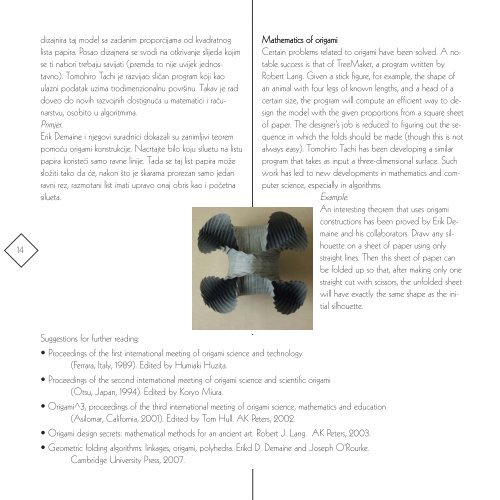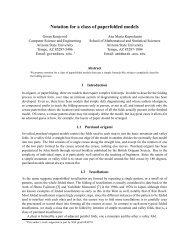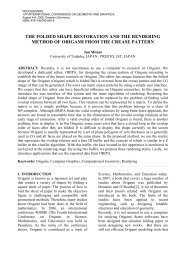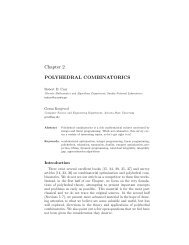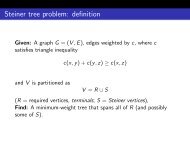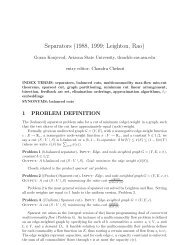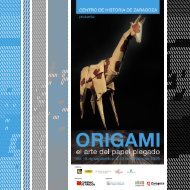POETRY IN PAPER POEZIJA U PAPIRU - Organic Origami
POETRY IN PAPER POEZIJA U PAPIRU - Organic Origami
POETRY IN PAPER POEZIJA U PAPIRU - Organic Origami
You also want an ePaper? Increase the reach of your titles
YUMPU automatically turns print PDFs into web optimized ePapers that Google loves.
14<br />
dizajnira taj model sa zadanim proporcijama od kvadratnog<br />
lista papira. Posao dizajnera se svodi na otkrivanje slijeda kojim<br />
se ti nabori trebaju savijati (premda to nije uvijek jednostavno).<br />
Tomohiro Tachi je razvijao sličan program koji kao<br />
ulazni podatak uzima trodimenzionalnu površinu. Takav je rad<br />
doveo do novih razvojnih dostignuća u matematici i računarstvu,<br />
osobito u algoritmima.<br />
Primjer.<br />
Erik Demaine i njegovi suradnici dokazali su zanimljivi teorem<br />
pomoću origami konstrukcije. Nacrtajte bilo koju siluetu na listu<br />
papira koristeći samo ravne linije. Tada se taj list papira može<br />
složiti tako da će, nakon što je škarama prorezan samo jedan<br />
ravni rez, razmotani list imati upravo onaj obris kao i početna<br />
silueta.<br />
Mathematics of origami<br />
Certain problems related to origami have been solved. A notable<br />
success is that of TreeMaker, a program written by<br />
Robert Lang. Given a stick figure, for example, the shape of<br />
an animal with four legs of known lengths, and a head of a<br />
certain size, the program will compute an efficient way to design<br />
the model with the given proportions from a square sheet<br />
of paper. The designer's job is reduced to figuring out the sequence<br />
in which the folds should be made (though this is not<br />
always easy). Tomohiro Tachi has been developing a similar<br />
program that takes as input a three-dimensional surface. Such<br />
work has led to new developments in mathematics and computer<br />
science, especially in algorithms.<br />
Example.<br />
An interesting theorem that uses origami<br />
constructions has been proved by Erik Demaine<br />
and his collaborators. Draw any silhouette<br />
on a sheet of paper using only<br />
straight lines. Then this sheet of paper can<br />
be folded up so that, after making only one<br />
straight cut with scissors, the unfolded sheet<br />
will have exactly the same shape as the initial<br />
silhouette.<br />
Suggestions for further reading:<br />
• Proceedings of the first international meeting of origami science and technology<br />
(Ferrara, Italy, 1989). Edited by Humiaki Huzita.<br />
• Proceedings of the second international meeting of origami science and scientific origami<br />
(Otsu, Japan, 1994). Edited by Koryo Miura.<br />
• <strong>Origami</strong>^3, proceedings of the third international meeting of origami science, mathematics and education<br />
(Asilomar, California, 2001). Edited by Tom Hull. AK Peters, 2002.<br />
• <strong>Origami</strong> design secrets: mathematical methods for an ancient art. Robert J. Lang. AK Peters, 2003.<br />
• Geometric folding algorithms: linkages, origami, polyhedra. Erikd D. Demaine and Joseph O'Rourke.<br />
Cambridge University Press, 2007.


